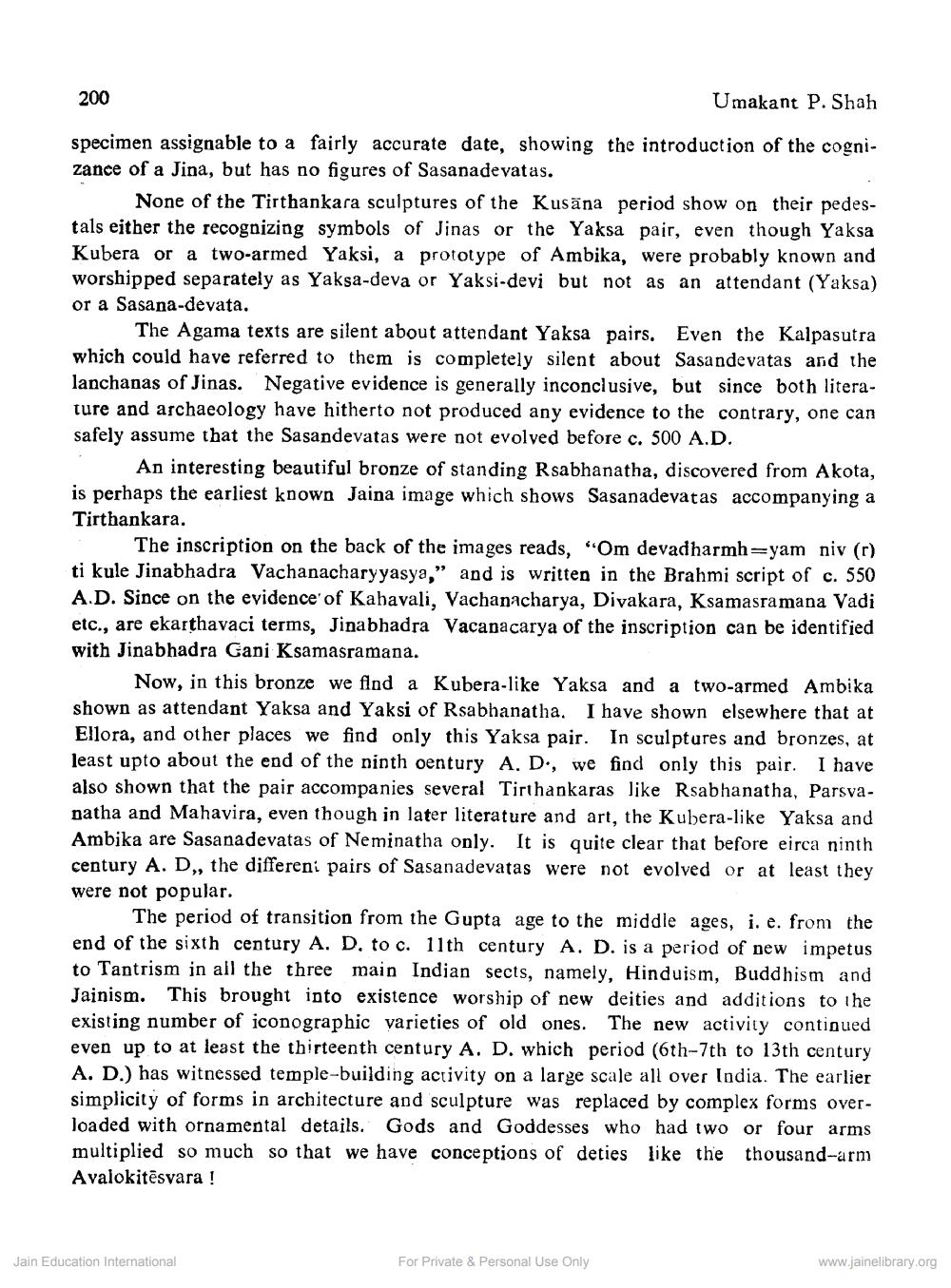________________
200
Umakant P. Shah
Non
specimen assignable to a fairly accurate date, showing the introduction of the cognizance of a Jina, but has no figures of Sasanadevatas.
None of the Tirthankara sculptures of the Kusāna period show on their pedestals either the recognizing symbols of Jinas or the Yaksa pair, even though Yaksa Kubera or a two-armed Yaksi, a prototype of Ambika, were probably known and worshipped separately as Yaksa-deva or Yaksi-devi but not as an attendant (Yaksa) or a Sasana-devata.
The Agama texts are silent about attendant Yaksa pairs. Even the Kalpasutra which could have referred to them is completely silent about Sasandevatas and the lanchanas of Jinas. Negative evidence is generally inconclusive, but since both literature and archaeology have hitherto not produced any evidence to the contrary, one can safely assume that the Sasandevatas were not evolved before c. 500 A.D.
An interesting beautiful bronze of standing Rsabhanatha, discovered from Akota, is perhaps the earliest known Jaina image which shows Sasanadevatas accompanying a Tirthankara.
The inscription on the back of the images reads, “Om devadharmh=yam niv (r) ti kule Jinabhadra Vachanacharyyasya,” and is written in the Brahmi script of c. 550 A.D. Since on the evidence of Kabavali, Vachanacharya, Divakara, Ksamasramana Vadi etc., are ekarthavaci terms, Jinabhadra Vacanacarya of the inscription can be identified with Jinabhadra Gani Ksamasramana.
Now, in this bronze we find a Kubera-like Yaksa and a two-armed Ambika shown as attendant Yaksa and Yaksi of Rsabhanatha. I have shown elsewhere that at Ellora, and other places we find only this Yaksa pair. In sculptures and bronzes, at least upto about the end of the ninth oentury A. D., we find only this pair. I have also shown that the pair accompanies several Tirthankaras like Rsabhanatha, Parsvanatha and Mahavira, even though in later literature and art, the Kubera-like Yaksa and Ambika are Sasanadevatas of Neminatha only. It is quite clear that before eirca ninth century A. D,, the differeni pairs of Sasanadevatas were not evolved or at least they were not popular.
The period of transition from the Gupta age to the middle ages, i. e. from the end of the sixth century A. D. to c. 11th century A. D. is a period of new impetus to Tantrism in all the three main Indian sects, namely, Hinduism, Buddhism and Jainism. This brought into existence worship of new deities and additions to the existing number of iconographic varieties of old ones. The new activity continued even up to at least the thirteenth century A. D. which period (6th-7th to 13th century A. D.) has witnessed temple-building activity on a large scale all over India. The earlier simplicity of forms in architecture and sculpture was replaced by complex forms overloaded with ornamental details. Gods and Goddesses who had two or four arms multiplied so much so that we have conceptions of deties like the thousand-arm Avalokitēsvara !
Jain Education International
For Private & Personal Use Only
www.jainelibrary.org




